Deck 1: Nokia Scalable IP Networks
Question
Question
Question
Question
Question
Question
Question
Question
Question
Question
Question
Question
Question
Question
Question
Question
Question
Question
Question
Question
Question
Question
Question
Question
Question
Question
Question
Question
Question
Question
Question
Question
Question
Question
Question
Question
Question
Question
Question
Question
Question
Question
Question
Question
Question
Question
Question
Question
Question
Question
Question
Question
Question
Question
Question
Question
Question
Question
Question
Question
Question
Question
Question
Question
Question
Question
Question
Question
Question
Question
Question
Question
Question
Question
Question
Question
Question
Question
Question
Question

Unlock Deck
Sign up to unlock the cards in this deck!
Unlock Deck
Unlock Deck
1/198
Play
Full screen (f)
Deck 1: Nokia Scalable IP Networks
1
Which of the following statements describe the primary objectives of the policing of traffic flows on the Nokia 7750 SR? (Choose two)
A) Ensure that traffic flows conform to their traffic profile.
B) Log violations of metered traffic flows exceeding the CIR value set on the entity across which the traffic is moving.
C) Provide fairness between traffic flows, so that conforming (in-profile) traffic flows are not starved of bandwidth and/or buffer space by non-conforming (out-of-profile) flows.
D) Minimize packet loss and reduce end to end latency.
E) Ensure that variable latencies do not cluster short bursts of originally conforming packets and render them nonconforming.
A) Ensure that traffic flows conform to their traffic profile.
B) Log violations of metered traffic flows exceeding the CIR value set on the entity across which the traffic is moving.
C) Provide fairness between traffic flows, so that conforming (in-profile) traffic flows are not starved of bandwidth and/or buffer space by non-conforming (out-of-profile) flows.
D) Minimize packet loss and reduce end to end latency.
E) Ensure that variable latencies do not cluster short bursts of originally conforming packets and render them nonconforming.
Ensure that traffic flows conform to their traffic profile.
Provide fairness between traffic flows, so that conforming (in-profile) traffic flows are not starved of bandwidth and/or buffer space by non-conforming (out-of-profile) flows.
Provide fairness between traffic flows, so that conforming (in-profile) traffic flows are not starved of bandwidth and/or buffer space by non-conforming (out-of-profile) flows.
2
Forwarding subclasses are only relevant to, and are therefore applied within the context of, a _____________policy.
A) network
B) scheduling
C) slope
D) SAP-ingress
E) network-queue
A) network
B) scheduling
C) slope
D) SAP-ingress
E) network-queue
SAP-ingress
3
What is the maximum number of SAP-ingress policies that can be applied on a SAP?
A) 1
B) 2
C) 3
D) 4
E) 5
F) 8
A) 1
B) 2
C) 3
D) 4
E) 5
F) 8
1
4
WRED can be used to help avoid TCP slow-start synch problems.

Unlock Deck
Unlock for access to all 198 flashcards in this deck.
Unlock Deck
k this deck
5
What is an SLA? (Choose two)
A) An SLA is used to provide automated, real-time testing and alarming for throughput, latency, and jitter across a provider's network.
B) An SLA is an agreement between a customer and a provider that dictates the treatment of customer traffic across the provider's network.
C) An SLA allows customers to control all traffic within the service provider's network by prioritizing their traffic over others as desired.
D) An SLA allows a customer to pre-mark traffic and ensure that traffic is treated as per the agreement within the provider's network.
E) An SLA is a standard set of network QoS policies that a provider shares to all its customers, allowing them to better understand the treatment of traffic within the provider's network.
A) An SLA is used to provide automated, real-time testing and alarming for throughput, latency, and jitter across a provider's network.
B) An SLA is an agreement between a customer and a provider that dictates the treatment of customer traffic across the provider's network.
C) An SLA allows customers to control all traffic within the service provider's network by prioritizing their traffic over others as desired.
D) An SLA allows a customer to pre-mark traffic and ensure that traffic is treated as per the agreement within the provider's network.
E) An SLA is a standard set of network QoS policies that a provider shares to all its customers, allowing them to better understand the treatment of traffic within the provider's network.

Unlock Deck
Unlock for access to all 198 flashcards in this deck.
Unlock Deck
k this deck
6
To manage the shared buffer space at network ports, slope policies are applied on _________ for the ingress direction, and on ________ or _________ for the egress direction.
A) Interfaces, ports, SAPs
B) Ports, ports, MDAs
C) MDAs, MDAs, ports
D) Interfaces, interfaces. MDAs
E) MDAs, ports, interfaces
A) Interfaces, ports, SAPs
B) Ports, ports, MDAs
C) MDAs, MDAs, ports
D) Interfaces, interfaces. MDAs
E) MDAs, ports, interfaces

Unlock Deck
Unlock for access to all 198 flashcards in this deck.
Unlock Deck
k this deck
7
Click the exhibit button below. Given the output of the #show pools 1/2/2 network-egress command on a GigE port, what can the service provider deduce? (Choose two) 
A) QoS is not configured on the router.
B) Packets in forwarding classes "be" and "12" are being queued.
C) Traffic belonging to forwarding class "ef" is not experiencing queuing delays.
D) Traffic belonging to forwarding class "11 "will never make use of the shared buffer pool.
E) Out-of-profile traffic in the shared buffer pool is being dropped.

A) QoS is not configured on the router.
B) Packets in forwarding classes "be" and "12" are being queued.
C) Traffic belonging to forwarding class "ef" is not experiencing queuing delays.
D) Traffic belonging to forwarding class "11 "will never make use of the shared buffer pool.
E) Out-of-profile traffic in the shared buffer pool is being dropped.

Unlock Deck
Unlock for access to all 198 flashcards in this deck.
Unlock Deck
k this deck
8
Which of the following are NOT ingress matching criteria for a network policy? (Choose two)
A) TCP port numbers
B) LSP EXP
C) DSCP
D) Source and destination IP addresses
E) Dot1p priority
A) TCP port numbers
B) LSP EXP
C) DSCP
D) Source and destination IP addresses
E) Dot1p priority

Unlock Deck
Unlock for access to all 198 flashcards in this deck.
Unlock Deck
k this deck
9
How many queues are available for use on service egress within a VPLS service?
A) 1 multipoint and 8 unicast.
B) 8 queues, regardless of traffic type.
C) 8 unicast and 24 multipoint.
D) 8 unicast and 8 multipoint.
E) 16 queues, distributed as desired.
A) 1 multipoint and 8 unicast.
B) 8 queues, regardless of traffic type.
C) 8 unicast and 24 multipoint.
D) 8 unicast and 8 multipoint.
E) 16 queues, distributed as desired.

Unlock Deck
Unlock for access to all 198 flashcards in this deck.
Unlock Deck
k this deck
10
A queue is configured with the following attributes: MBS = 10KB CBS = 5KB High-Priority-Only = 20% Assume that there is no CBS overbooking and that the slope-policy is disabled. If the current queue depth is 3KB, what will happen to an out-of-profile packet arriving at an egress queue?
A) It will be queued in the reserved portion of the buffer pool and remain out-of-profile.
B) It will be queued in the reserved portion of the buffer pool if there are no in-profile packets already in the queue.
C) It will be queued in the reserved portion of the buffer pool and be in-profile.
D) It will be queued in the shared portion of the buffer pool but contend for shared buffer space with packets from other queues.
E) It will be queued in the shared portion of the buffer pool but may be dropped if the buffer utilization exceeds the start-average value of the low slope.
A) It will be queued in the reserved portion of the buffer pool and remain out-of-profile.
B) It will be queued in the reserved portion of the buffer pool if there are no in-profile packets already in the queue.
C) It will be queued in the reserved portion of the buffer pool and be in-profile.
D) It will be queued in the shared portion of the buffer pool but contend for shared buffer space with packets from other queues.
E) It will be queued in the shared portion of the buffer pool but may be dropped if the buffer utilization exceeds the start-average value of the low slope.

Unlock Deck
Unlock for access to all 198 flashcards in this deck.
Unlock Deck
k this deck
11
Click the exhibit button below. A partial SAP-ingress policy configuration is shown below. A UDP video stream is sent to a PC with IP address 192.168.1.100. Given the SAP-ingress policy, to which forwarding class is the traffic matched? 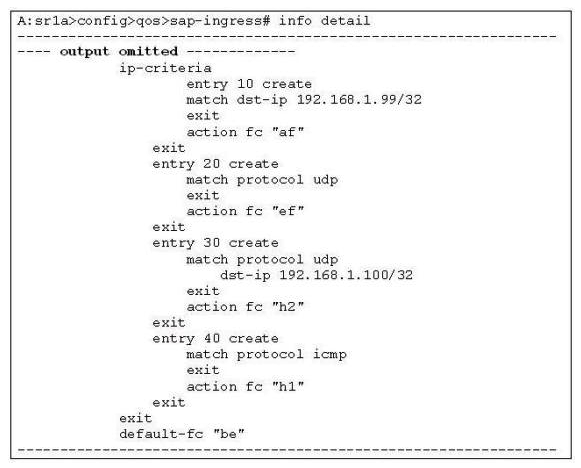
A) AF
B) EF
C) H2
D) H1
E) BE

A) AF
B) EF
C) H2
D) H1
E) BE

Unlock Deck
Unlock for access to all 198 flashcards in this deck.
Unlock Deck
k this deck
12
Which of the following statements regarding DSCP bits are TRUE? (Choose three)
A) The three most significant (first) bits define 8 forwarding classes.
B) The three least significant (last) bits of the DSCP specify the drop probability.
C) The full 8 bits of the TOS field are used for DSCP.
D) To convert DSCP to IP precedence, the three most significant (first) bits are matched.
E) DSCP provides for eight drop probabilities.
A) The three most significant (first) bits define 8 forwarding classes.
B) The three least significant (last) bits of the DSCP specify the drop probability.
C) The full 8 bits of the TOS field are used for DSCP.
D) To convert DSCP to IP precedence, the three most significant (first) bits are matched.
E) DSCP provides for eight drop probabilities.

Unlock Deck
Unlock for access to all 198 flashcards in this deck.
Unlock Deck
k this deck
13
Click the exhibit button below.  Based on the configuration shown below, name the forwarding class to be associated with a TCP packet encapsulated inside an Ethernet frame that arrives on SAP 1/1/5 with the following characteristics: Destination IP address = 120.110.1.1 TCP port number = 23 DSCP value = nc1 Dot1pvalue = 3
Based on the configuration shown below, name the forwarding class to be associated with a TCP packet encapsulated inside an Ethernet frame that arrives on SAP 1/1/5 with the following characteristics: Destination IP address = 120.110.1.1 TCP port number = 23 DSCP value = nc1 Dot1pvalue = 3
A) H2
B) NC
C) L2
D) EF
E) H1
F) BE
 Based on the configuration shown below, name the forwarding class to be associated with a TCP packet encapsulated inside an Ethernet frame that arrives on SAP 1/1/5 with the following characteristics: Destination IP address = 120.110.1.1 TCP port number = 23 DSCP value = nc1 Dot1pvalue = 3
Based on the configuration shown below, name the forwarding class to be associated with a TCP packet encapsulated inside an Ethernet frame that arrives on SAP 1/1/5 with the following characteristics: Destination IP address = 120.110.1.1 TCP port number = 23 DSCP value = nc1 Dot1pvalue = 3A) H2
B) NC
C) L2
D) EF
E) H1
F) BE

Unlock Deck
Unlock for access to all 198 flashcards in this deck.
Unlock Deck
k this deck
14
Which of the following are the minimum requirements needed to classify traffic marked with DSCP AF11, AF12, and AF13 into the AF forwarding class and provide fair treatment to the drop precedence settings? (Choose three)
A) Profile mode queues
B) Priority mode queues
C) 1 queue
D) 3 queues
E) 3 forwarding classes
F) 1 forwarding class, with 2 subclasses
G) 1 forwarding class, with 3 subclasses
A) Profile mode queues
B) Priority mode queues
C) 1 queue
D) 3 queues
E) 3 forwarding classes
F) 1 forwarding class, with 2 subclasses
G) 1 forwarding class, with 3 subclasses

Unlock Deck
Unlock for access to all 198 flashcards in this deck.
Unlock Deck
k this deck
15
Which of the following are characteristics of 802.1p? (Choose two)
A) 802.1p adds 16 bits to the Layer 2 header,
B) 802.1p adds 16 bits to the Layer 3 header.
C) 802.1p specifies 64 different priority levels.
D) 802.1p uses a field in the 802.1Q header.
E) 802.1p uses a field in the Layer 3 IP header
F) 802.1p defines a 3-bit Class of Service field.
A) 802.1p adds 16 bits to the Layer 2 header,
B) 802.1p adds 16 bits to the Layer 3 header.
C) 802.1p specifies 64 different priority levels.
D) 802.1p uses a field in the 802.1Q header.
E) 802.1p uses a field in the Layer 3 IP header
F) 802.1p defines a 3-bit Class of Service field.

Unlock Deck
Unlock for access to all 198 flashcards in this deck.
Unlock Deck
k this deck
16
The IP ToS field consists of ________ bits, of which ________are used. The _________most significant (first) bits define precedence.
A) 8, 6, 3
B) 8, 8, 6
C) 16, 8, 4
D) 8, 6, 4
E) 24, 16, 8
A) 8, 6, 3
B) 8, 8, 6
C) 16, 8, 4
D) 8, 6, 4
E) 24, 16, 8

Unlock Deck
Unlock for access to all 198 flashcards in this deck.
Unlock Deck
k this deck
17
Which of the following can be used as classifiers of customer traffic? (Choose three)
A) DSCP value
B) 802.1p value
C) IP DF bit
D) TCP/UDP port numbers
E) HTML version number
A) DSCP value
B) 802.1p value
C) IP DF bit
D) TCP/UDP port numbers
E) HTML version number

Unlock Deck
Unlock for access to all 198 flashcards in this deck.
Unlock Deck
k this deck
18
What is the 6-bit binary representation of DSCP value AF21?
A) 010011
B) 100010
C) 010001
D) 001100
E) 010010
A) 010011
B) 100010
C) 010001
D) 001100
E) 010010

Unlock Deck
Unlock for access to all 198 flashcards in this deck.
Unlock Deck
k this deck
19
Click the exhibit button below. A service provider has applied the SAP-ingress policy configuration below on his customer's SAP. The service provider notices that all of the customer's traffic is being dropped at the SAP-ingress. Which of the following actions can resolve the problem, if applied on its own? (Choose three) 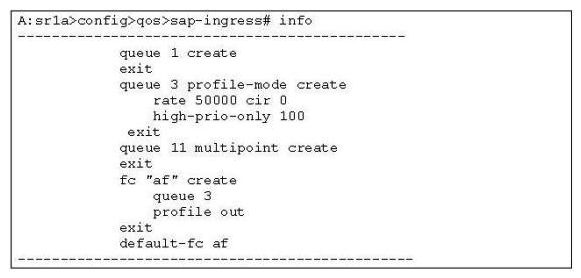
A) Set the CIR of queue 3 to a non-zero value corresponding to the customer's expected bandwidth requirements.
B) Set queue 3 to use priority mode.
C) Set the traffic classification of packets to in-profile.
D) Set the high-priority-only value to 0.
E) Map AF traffic to queue 1

A) Set the CIR of queue 3 to a non-zero value corresponding to the customer's expected bandwidth requirements.
B) Set queue 3 to use priority mode.
C) Set the traffic classification of packets to in-profile.
D) Set the high-priority-only value to 0.
E) Map AF traffic to queue 1

Unlock Deck
Unlock for access to all 198 flashcards in this deck.
Unlock Deck
k this deck
20
Which of the following should be performed if a service provider does not want packets to make use of the shared buffer space when queued?
A) Set the CBS to 0.
B) Set the MBS equal to the CBS.
C) Set the high-priority-only equal to the MBS.
D) Set the MBS to 0.
E) Set the high-priority-only to 0.
A) Set the CBS to 0.
B) Set the MBS equal to the CBS.
C) Set the high-priority-only equal to the MBS.
D) Set the MBS to 0.
E) Set the high-priority-only to 0.

Unlock Deck
Unlock for access to all 198 flashcards in this deck.
Unlock Deck
k this deck
21
Which of the following statements are TRUE when discussing self-generated traffic QoS? (Choose two)
A) In order to mark Layer 2 traffic, sgt-qos will set various ToS bits.
B) DSCP bits can be set per application, per routing instance.
C) The DSCP marking stays nc1 for all applications. Only the internal FC is manipulated across different applications.
D) In order to mark Layer 2 self-generated traffic, network interfaces must be set to dot1Q.
E) The internal forwarding class for self-generated traffic is set once and applied to the base router and all VPRN instances.
A) In order to mark Layer 2 traffic, sgt-qos will set various ToS bits.
B) DSCP bits can be set per application, per routing instance.
C) The DSCP marking stays nc1 for all applications. Only the internal FC is manipulated across different applications.
D) In order to mark Layer 2 self-generated traffic, network interfaces must be set to dot1Q.
E) The internal forwarding class for self-generated traffic is set once and applied to the base router and all VPRN instances.

Unlock Deck
Unlock for access to all 198 flashcards in this deck.
Unlock Deck
k this deck
22
Click the exhibit button below. A network operator has configured the SAP-ingress policy below. Ping traffic is expected in queue 3. However, the network operator notices that all traffic is placed in queue 1. What is the most probable reason for this? 
A) The default forwarding class for all traffic, including ICMP, is BE, which is placed in queue 1.
B) The SAP has been shut down.
C) The IP-match criteria has been misconfigured for ICMP traffic.
D) Queue 3 has no rate or CIR configured and thus cannot hold any packets.
E) The SAP-ingress policy has not been applied to the SAP.

A) The default forwarding class for all traffic, including ICMP, is BE, which is placed in queue 1.
B) The SAP has been shut down.
C) The IP-match criteria has been misconfigured for ICMP traffic.
D) Queue 3 has no rate or CIR configured and thus cannot hold any packets.
E) The SAP-ingress policy has not been applied to the SAP.

Unlock Deck
Unlock for access to all 198 flashcards in this deck.
Unlock Deck
k this deck
23
A queue is configured with the following attributes: MBS = 10KB CBS = 5KB High-Priority-Only = 30% Assume that there is no CBS overbooking and that the slope-policy is disabled. If the current queue depth is 8KB, what will happen to an in-profile packet arriving in the queue?
A) It will be discarded because the high-priority-only threshold is exceeded.
B) It will be queued but re-marked as "out-of-profile."
C) It will be queued in the reserved portion of the buffer pool and remain "in-profile."
D) It will be queued in the shared portion of the buffer pool but contend for shared buffer space with packets from other queues.
E) It will be queued in the shared portion of the buffer pool but may be dropped if the buffer utilization exceeds the start-average value of the low slope.
A) It will be discarded because the high-priority-only threshold is exceeded.
B) It will be queued but re-marked as "out-of-profile."
C) It will be queued in the reserved portion of the buffer pool and remain "in-profile."
D) It will be queued in the shared portion of the buffer pool but contend for shared buffer space with packets from other queues.
E) It will be queued in the shared portion of the buffer pool but may be dropped if the buffer utilization exceeds the start-average value of the low slope.

Unlock Deck
Unlock for access to all 198 flashcards in this deck.
Unlock Deck
k this deck
24
A packet is to be encapsulated inside an MPLS tunnel which consists of two MPLS headers at the first network egress. Which of the MPLS EXP fields will be marked?
A) The EXP field in the bottom MPLS header will be marked.
B) The EXP field in both the top and bottom MPLS headers will be marked.
C) For Layer 2 services, the top MPLS header will be marked; for Layer 3 services, the bottom MPLS header will be marked.
D) The EXP field in the top MPLS header will be marked.
E) Neither the top nor the bottom EXP field will be marked since EXP remarking can only be done on the network ingress.
A) The EXP field in the bottom MPLS header will be marked.
B) The EXP field in both the top and bottom MPLS headers will be marked.
C) For Layer 2 services, the top MPLS header will be marked; for Layer 3 services, the bottom MPLS header will be marked.
D) The EXP field in the top MPLS header will be marked.
E) Neither the top nor the bottom EXP field will be marked since EXP remarking can only be done on the network ingress.

Unlock Deck
Unlock for access to all 198 flashcards in this deck.
Unlock Deck
k this deck
25
At which points can traffic be marked or remarked on the Nokia 7750? (Choose two)
A) SAP-ingress only
B) SAP-egress only
C) SAP-ingress and SAP-egress
D) Network ingress
E) Network egress
A) SAP-ingress only
B) SAP-egress only
C) SAP-ingress and SAP-egress
D) Network ingress
E) Network egress

Unlock Deck
Unlock for access to all 198 flashcards in this deck.
Unlock Deck
k this deck
26
Which of the following statements are TRUE? (Choose two)
A) The primary contributors to latency are distance, scheduling, and congestion.
B) The weighted round robin scheduling algorithm will result in more delay for high priority traffic than the regular round robin algorithm.
C) The round robin scheduling algorithm will result in less jitter for low priority traffic than a strict priority scheduler.
D) Packet loss can be reduced by decreasing the amount of buffer space available to a queue.
E) Latency can be reduced by increasing the amount of buffer space available to a queue.
A) The primary contributors to latency are distance, scheduling, and congestion.
B) The weighted round robin scheduling algorithm will result in more delay for high priority traffic than the regular round robin algorithm.
C) The round robin scheduling algorithm will result in less jitter for low priority traffic than a strict priority scheduler.
D) Packet loss can be reduced by decreasing the amount of buffer space available to a queue.
E) Latency can be reduced by increasing the amount of buffer space available to a queue.

Unlock Deck
Unlock for access to all 198 flashcards in this deck.
Unlock Deck
k this deck
27
Which of the following statements regarding policing and shaping on the Nokia 7750 SR are TRUE? (Choose two)
A) The larger the configured MBS value, the lower the amount of shaping performed.
B) When policing is enabled on the SAP-ingress, all traffic is considered as in-profile.
C) Setting the CIR to 1000 and the PIR to max will enable shapeless policing at 1 Mbps within the SAP-egress policy.
D) Configuring MBS to equal CBS will disable shaping.
E) Setting the CIR and PIR to equal values disables soft-policing.
A) The larger the configured MBS value, the lower the amount of shaping performed.
B) When policing is enabled on the SAP-ingress, all traffic is considered as in-profile.
C) Setting the CIR to 1000 and the PIR to max will enable shapeless policing at 1 Mbps within the SAP-egress policy.
D) Configuring MBS to equal CBS will disable shaping.
E) Setting the CIR and PIR to equal values disables soft-policing.

Unlock Deck
Unlock for access to all 198 flashcards in this deck.
Unlock Deck
k this deck
28
It is necessary for Tier 1 schedulers to obtain bandwidth from a higher tier scheduler.

Unlock Deck
Unlock for access to all 198 flashcards in this deck.
Unlock Deck
k this deck
29
Which of the following entities can scheduler policies be applied to? (Choose two)
A) Network ingress port
B) Epipe ingress SAP
C) ES egress SAP
D) Ingress MDA
E) VPRN ingress interface
F) Shared buffer space
A) Network ingress port
B) Epipe ingress SAP
C) ES egress SAP
D) Ingress MDA
E) VPRN ingress interface
F) Shared buffer space

Unlock Deck
Unlock for access to all 198 flashcards in this deck.
Unlock Deck
k this deck
30
When using an egress port scheduler, on which scheduling loop are orphaned queues serviced?
A) Level 8 within CIR.
B) Level 8 between CIR and PIR.
C) Level 8, once all PIR is serviced.
D) Level 1 within CIR.
E) Level 1 between CIR and PIR.
F) Level 1, once all PIR is serviced.
A) Level 8 within CIR.
B) Level 8 between CIR and PIR.
C) Level 8, once all PIR is serviced.
D) Level 1 within CIR.
E) Level 1 between CIR and PIR.
F) Level 1, once all PIR is serviced.

Unlock Deck
Unlock for access to all 198 flashcards in this deck.
Unlock Deck
k this deck
31
On the Nokia 7750 SR, how many queues per FC are available for multipoint traffic within a VPLS on service ingress?
A) 64
B) 8
C) 3
D) 16
E) 1
A) 64
B) 8
C) 3
D) 16
E) 1

Unlock Deck
Unlock for access to all 198 flashcards in this deck.
Unlock Deck
k this deck
32
Which of the following are possible criteria for classifying packets at the SAP-ingress? (Choose three)
A) The EXP bits in the MPLS header.
B) The packet's source and destination IP addresses.
C) The service ID of the service to which the SAP belongs.
D) The dot1p bits in the frame header.
E) The packet's Ethertype.
A) The EXP bits in the MPLS header.
B) The packet's source and destination IP addresses.
C) The service ID of the service to which the SAP belongs.
D) The dot1p bits in the frame header.
E) The packet's Ethertype.

Unlock Deck
Unlock for access to all 198 flashcards in this deck.
Unlock Deck
k this deck
33
Without_______, a customer's high priority traffic can be dropped before its low priority traffic.
A) packet filtering
B) prioritization of traffic flows
C) least cost routing
D) OAM functionality
E) separation between the data plane and the control plane
A) packet filtering
B) prioritization of traffic flows
C) least cost routing
D) OAM functionality
E) separation between the data plane and the control plane

Unlock Deck
Unlock for access to all 198 flashcards in this deck.
Unlock Deck
k this deck
34
Click the exhibit button below. Given the SAP-ingress policy, which of the following statements are TRUE? (Choose three) 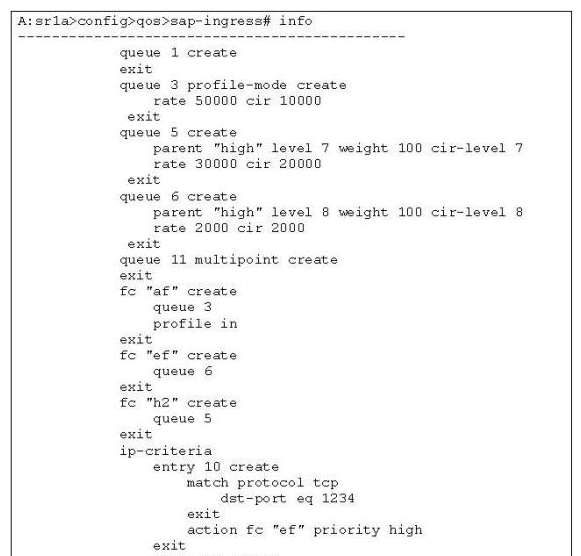
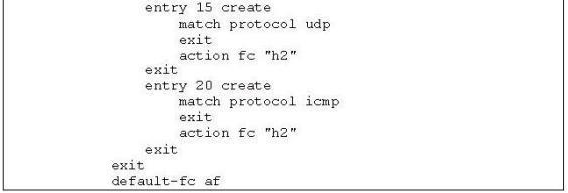
A) All AF traffic will be marked "in-profile" at the SAP-ingress.
B) All TCP traffic will be mapped to forwarding class EF.
C) UDP traffic is placed in queue 3 while ICMP traffic is placed in queue 5.
D) EF traffic will receive higher scheduling priority than H2 traffic.
E) Traffic that does not match any of the IP criteria will be placed in queue 3.


A) All AF traffic will be marked "in-profile" at the SAP-ingress.
B) All TCP traffic will be mapped to forwarding class EF.
C) UDP traffic is placed in queue 3 while ICMP traffic is placed in queue 5.
D) EF traffic will receive higher scheduling priority than H2 traffic.
E) Traffic that does not match any of the IP criteria will be placed in queue 3.

Unlock Deck
Unlock for access to all 198 flashcards in this deck.
Unlock Deck
k this deck
35
In which of the following scenarios is self-generated traffic QoS (sgt-QoS) useful?
A) EXP markings on transit control traffic are not set correctly.
B) The priority of all self-generated traffic needs to be lowered to allow all other traffic to take precedence.
C) The priority of various control packets requires special treatment throughout the network.
D) The BGP process is consuming too many CPU cycles and is impacting OSPF performance.
A) EXP markings on transit control traffic are not set correctly.
B) The priority of all self-generated traffic needs to be lowered to allow all other traffic to take precedence.
C) The priority of various control packets requires special treatment throughout the network.
D) The BGP process is consuming too many CPU cycles and is impacting OSPF performance.

Unlock Deck
Unlock for access to all 198 flashcards in this deck.
Unlock Deck
k this deck
36
Which of the following statements regarding egress FC and profile over-ride are TRUE? (Choose two)
A) Packets can be classified into 16 different FCs when using priority mode queuing.
B) This feature is available on egress SAPs within any service.
C) MPLS EXP bits can be changed based on multi-field classification.
D) If a Behavior Aggregate (BA) and Multi-field (MF) match occurs, only the MF override parameters will take effect.
E) If a Behavior Aggregate (BA) and Multi-field (MF) match occurs, the BA classification can override the forwarding class while the MF classification can override the profile.
A) Packets can be classified into 16 different FCs when using priority mode queuing.
B) This feature is available on egress SAPs within any service.
C) MPLS EXP bits can be changed based on multi-field classification.
D) If a Behavior Aggregate (BA) and Multi-field (MF) match occurs, only the MF override parameters will take effect.
E) If a Behavior Aggregate (BA) and Multi-field (MF) match occurs, the BA classification can override the forwarding class while the MF classification can override the profile.

Unlock Deck
Unlock for access to all 198 flashcards in this deck.
Unlock Deck
k this deck
37
To implement Hierarchical-QoS (Multi-tiered scheduling), which of the following actions must be undertaken? (Choose three)
A) H-QoS capabilities must be enabled globally on the router
B) A scheduler-policy must be configured.
C) The queues in the SAP-ingress and SAP-egress policies do not require additional configuration attributes to make use of the hierarchical schedulers.
D) The network queue policy must be configured to make use of the scheduler-policy.
E) The scheduler-policy must be referenced in the SAP-ingress and SAP-egress policies.
F) The scheduler-policy must be applied on the service SAP.
A) H-QoS capabilities must be enabled globally on the router
B) A scheduler-policy must be configured.
C) The queues in the SAP-ingress and SAP-egress policies do not require additional configuration attributes to make use of the hierarchical schedulers.
D) The network queue policy must be configured to make use of the scheduler-policy.
E) The scheduler-policy must be referenced in the SAP-ingress and SAP-egress policies.
F) The scheduler-policy must be applied on the service SAP.

Unlock Deck
Unlock for access to all 198 flashcards in this deck.
Unlock Deck
k this deck
38
Click the exhibit button below. Given this scheduler-policy configuration, which of the following can be said about the scheduler called "high"? (Choose two) 
A) It is a parent scheduler.
B) It is the top-level scheduler.
C) It can allocate up to 50 Mbps of bandwidth to scheduler "low" since the bandwidth is not used by another Tier 3 scheduler.
D) It is a child scheduler.
E) It can only have queues as children.

A) It is a parent scheduler.
B) It is the top-level scheduler.
C) It can allocate up to 50 Mbps of bandwidth to scheduler "low" since the bandwidth is not used by another Tier 3 scheduler.
D) It is a child scheduler.
E) It can only have queues as children.

Unlock Deck
Unlock for access to all 198 flashcards in this deck.
Unlock Deck
k this deck
39
Which of the following are trusted boundaries, by default? (Choose two)
A) An IES SAP
B) A VPLS SAP
C) A network port
D) AVPRN SAP
E) An access port
A) An IES SAP
B) A VPLS SAP
C) A network port
D) AVPRN SAP
E) An access port

Unlock Deck
Unlock for access to all 198 flashcards in this deck.
Unlock Deck
k this deck
40
On the Nokia 7750 SR, what is a slope policy used for?
A) Defining the slope of the TCP slow-start mechanism for self generated traffic.
B) Defining the slope of the scheduling rate per forwarding class when using HQoS.
C) Defining the high and low slope values when deploying buffer admission control for UDP traffic in the committed buffer pool.
D) Defining the high and low slope values when deploying buffer admission control for TCP traffic in the shared buffer pool.
E) Defining the high and low slope values when deploying buffer admission control for TCP traffic in the committed buffer pool.
A) Defining the slope of the TCP slow-start mechanism for self generated traffic.
B) Defining the slope of the scheduling rate per forwarding class when using HQoS.
C) Defining the high and low slope values when deploying buffer admission control for UDP traffic in the committed buffer pool.
D) Defining the high and low slope values when deploying buffer admission control for TCP traffic in the shared buffer pool.
E) Defining the high and low slope values when deploying buffer admission control for TCP traffic in the committed buffer pool.

Unlock Deck
Unlock for access to all 198 flashcards in this deck.
Unlock Deck
k this deck
41
When allocating scheduling resources, which of the following statements BEST describes how the egress port scheduler allocates bandwidth?
A) The egress port scheduler takes the ratio of requested bandwidth to total bandwidth request from all children. It allocates bandwidth fairly, using these percentages and not exceeding the egress interface speed.
B) The egress port scheduler allocates bandwidth based on a WRR distribution method that takes into account the CIR and PIR requested at each level and the max speed, either default or configured, on egress.
C) The egress port scheduler allocates bandwidth on a first come, first served distribution method that takes into account the total CIR and PIR requested at each level and the max PIR requested from a single level.
D) The egress port scheduler will limit the bandwidth offered to the egress port based on the over-subscription factor, provisioned under the router interface, while using a WRR scheduler for the remaining bandwidth.
E) The egress port scheduler will use the Russian Dolls Method to allocate bandwidth to each level of requested bandwidth. HPO-Only is automatically set to 100%, allowing only high priority traffic to be buffered during congestion.
A) The egress port scheduler takes the ratio of requested bandwidth to total bandwidth request from all children. It allocates bandwidth fairly, using these percentages and not exceeding the egress interface speed.
B) The egress port scheduler allocates bandwidth based on a WRR distribution method that takes into account the CIR and PIR requested at each level and the max speed, either default or configured, on egress.
C) The egress port scheduler allocates bandwidth on a first come, first served distribution method that takes into account the total CIR and PIR requested at each level and the max PIR requested from a single level.
D) The egress port scheduler will limit the bandwidth offered to the egress port based on the over-subscription factor, provisioned under the router interface, while using a WRR scheduler for the remaining bandwidth.
E) The egress port scheduler will use the Russian Dolls Method to allocate bandwidth to each level of requested bandwidth. HPO-Only is automatically set to 100%, allowing only high priority traffic to be buffered during congestion.

Unlock Deck
Unlock for access to all 198 flashcards in this deck.
Unlock Deck
k this deck
42
On the Nokia 7750 SR, what is the maximum number of queues that a single SAP-ingress policy can support in a VPLS?
A) 16
B) 8
C) 32
D) 48
E) 56
A) 16
B) 8
C) 32
D) 48
E) 56

Unlock Deck
Unlock for access to all 198 flashcards in this deck.
Unlock Deck
k this deck
43
Click the exhibit button below. The service provider has both a VLL (epipe) service and a VPLS, as shown in the diagram below. 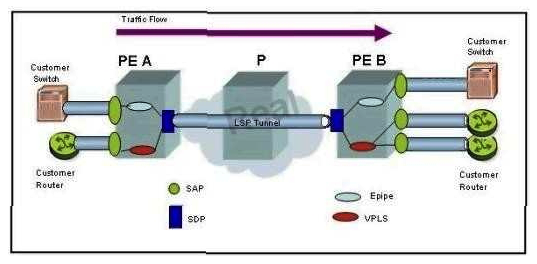 At router PE B, traffic arriving from both services will have the same network-queue policy applied.
At router PE B, traffic arriving from both services will have the same network-queue policy applied.
 At router PE B, traffic arriving from both services will have the same network-queue policy applied.
At router PE B, traffic arriving from both services will have the same network-queue policy applied.
Unlock Deck
Unlock for access to all 198 flashcards in this deck.
Unlock Deck
k this deck
44
Which of the following fields can be marked or remarked for frames belonging to a Layer 2 service?
A) DSCP
B) PREC
C) Dot1p
D) ToS
E) Q-in-Q
A) DSCP
B) PREC
C) Dot1p
D) ToS
E) Q-in-Q

Unlock Deck
Unlock for access to all 198 flashcards in this deck.
Unlock Deck
k this deck
45
Which of the following statements regarding the default scheduler in the Nokia 7750 SR are TRUE? (Choose two)
A) There are a maximum of 8 levels of priority serviced using a round-robin algorithm.
B) The default scheduler will spend an equal amount of time in each queue, as long as there is traffic present
C) The H1 internal forwarding class will receive its CIR before AF traffic.
D) Orphaned queues will be scheduled out of the BE queue.
E) A queue servicing EF and AF traffic will require explicit configuration to set the queue to expedited.
A) There are a maximum of 8 levels of priority serviced using a round-robin algorithm.
B) The default scheduler will spend an equal amount of time in each queue, as long as there is traffic present
C) The H1 internal forwarding class will receive its CIR before AF traffic.
D) Orphaned queues will be scheduled out of the BE queue.
E) A queue servicing EF and AF traffic will require explicit configuration to set the queue to expedited.

Unlock Deck
Unlock for access to all 198 flashcards in this deck.
Unlock Deck
k this deck
46
Click the exhibit button below. A network operator has configured a network-queue policy to map forwarding classes to queues, as shown in the exhibit below. Based on the default scheduling behavior of the Nokia 7750 SR, in which order will packets be serviced? 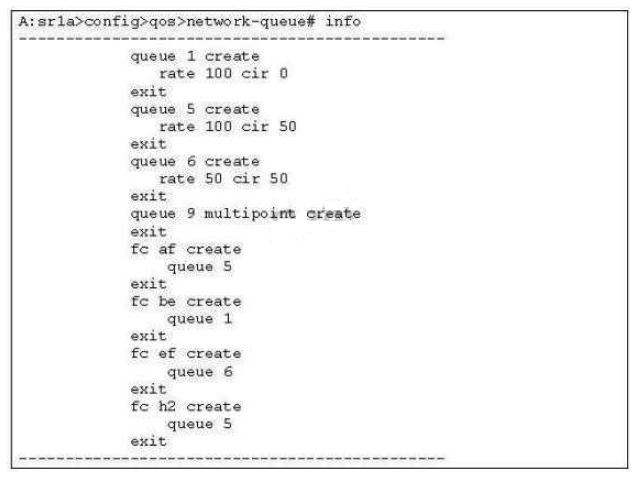
A) All in-profile packets in round-robin, then all out-of-profile packets in biased round-robin.
B) In-profile EF packets, then in-profile H2 packets, then in-profile AF packets, then out-of-profile EF packets, then out-of-profile H2 and AF packets, and then out-of-profile BE packets.
C) In-profile EF, H2 and AF packets, then out-of-profile H2, AF and BE packets in biased round-robin.
D) In-profile EF packets, then in-profile H2 and AF packets, then out-of-profile H2, AF and BE packets in biased round-robin.
E) In-profile EF and H2 packets, then in-profile AF packets, then out-of-profile H2, AF and BE packets in biased round-robin.

A) All in-profile packets in round-robin, then all out-of-profile packets in biased round-robin.
B) In-profile EF packets, then in-profile H2 packets, then in-profile AF packets, then out-of-profile EF packets, then out-of-profile H2 and AF packets, and then out-of-profile BE packets.
C) In-profile EF, H2 and AF packets, then out-of-profile H2, AF and BE packets in biased round-robin.
D) In-profile EF packets, then in-profile H2 and AF packets, then out-of-profile H2, AF and BE packets in biased round-robin.
E) In-profile EF and H2 packets, then in-profile AF packets, then out-of-profile H2, AF and BE packets in biased round-robin.

Unlock Deck
Unlock for access to all 198 flashcards in this deck.
Unlock Deck
k this deck
47
Which of the following statements regarding scheduling on the Nokia 7750 SR is TRUE? (Choose two)
A) When using profile-mode queues, traffic that is marked as in-profile on ingress and scheduled in the above-CIR loop will still be considered as in-profile at egress.
B) When an HQoS strategy using an egress port-scheduler has been deployed, Tier 1 receives its scheduling rates based on the amount of egress bandwidth available for each forwarding class.
C) The greater the difference between PIR and CIR rates in a queue, the less likely a CIR will be provided.
D) Packets scheduled out of high-priority queues in the default scheduler will have a lower chance of packet loss at the expense of incurring a higher probability of delay.
E) When using priority-mode queues, traffic that is marked as in-profile on ingress and scheduled in the above-CIR loop will be considered as in-profile at egress.
A) When using profile-mode queues, traffic that is marked as in-profile on ingress and scheduled in the above-CIR loop will still be considered as in-profile at egress.
B) When an HQoS strategy using an egress port-scheduler has been deployed, Tier 1 receives its scheduling rates based on the amount of egress bandwidth available for each forwarding class.
C) The greater the difference between PIR and CIR rates in a queue, the less likely a CIR will be provided.
D) Packets scheduled out of high-priority queues in the default scheduler will have a lower chance of packet loss at the expense of incurring a higher probability of delay.
E) When using priority-mode queues, traffic that is marked as in-profile on ingress and scheduled in the above-CIR loop will be considered as in-profile at egress.

Unlock Deck
Unlock for access to all 198 flashcards in this deck.
Unlock Deck
k this deck
48
Which of the following QoS functions does the slope-policy perform?
A) Classification
B) Marking
C) Queuing
D) Congestion management
E) Scheduling
A) Classification
B) Marking
C) Queuing
D) Congestion management
E) Scheduling

Unlock Deck
Unlock for access to all 198 flashcards in this deck.
Unlock Deck
k this deck
49
Real-time rate limiting on the service ingress is a feature that performs_____________. Traffic above the defined PIR is ______________.
A) Policing, expedited
B) Metering, marked discard eligible
C) Marking, marked discard eligible
D) Policing, discarded
E) Shaping, discarded
A) Policing, expedited
B) Metering, marked discard eligible
C) Marking, marked discard eligible
D) Policing, discarded
E) Shaping, discarded

Unlock Deck
Unlock for access to all 198 flashcards in this deck.
Unlock Deck
k this deck
50
Click the exhibit button below. Each router is interconnected by a single GigE link, as shown in the diagram below. 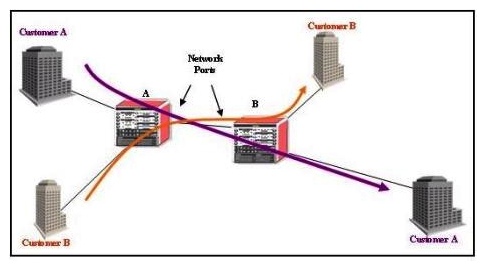 Note: The arrows show the direction of traffic flow. Traffic from Customer A and Customer B that is classified to the same forwarding class is queued together at the ingress of Router B
Note: The arrows show the direction of traffic flow. Traffic from Customer A and Customer B that is classified to the same forwarding class is queued together at the ingress of Router B
 Note: The arrows show the direction of traffic flow. Traffic from Customer A and Customer B that is classified to the same forwarding class is queued together at the ingress of Router B
Note: The arrows show the direction of traffic flow. Traffic from Customer A and Customer B that is classified to the same forwarding class is queued together at the ingress of Router B
Unlock Deck
Unlock for access to all 198 flashcards in this deck.
Unlock Deck
k this deck
51
Which of the following rate-limiting approaches are used on the Nokia 7750 SR? (Choose two)
A) Shapeless policing at SAP-ingress only.
B) Shapeless policing at SAP-ingress and egress.
C) Biased round robin queuing at ingress only.
D) Soft shaping at all network interfaces.
E) Soft shaping at network ingress only.
A) Shapeless policing at SAP-ingress only.
B) Shapeless policing at SAP-ingress and egress.
C) Biased round robin queuing at ingress only.
D) Soft shaping at all network interfaces.
E) Soft shaping at network ingress only.

Unlock Deck
Unlock for access to all 198 flashcards in this deck.
Unlock Deck
k this deck
52
Which of the following parameters are used in a hierarchical scheduler-policy to specify the priority of the child scheduler/queue for allocating bandwidth beyond its committed rate? (Choose two)
A) CIR
B) CIR level
C) CIR weight
D) Rate
E) Level
F) Weight
A) CIR
B) CIR level
C) CIR weight
D) Rate
E) Level
F) Weight

Unlock Deck
Unlock for access to all 198 flashcards in this deck.
Unlock Deck
k this deck
53
Which of the following are entities of the Nokia 7750 SR on which you can NOT apply a network-queue policy? (Choose three)
A) Router interfaces
B) Ingress MDA
C) Ingress Ethernet network ports
D) Egress Ethernet network ports
E) Service SAPs
A) Router interfaces
B) Ingress MDA
C) Ingress Ethernet network ports
D) Egress Ethernet network ports
E) Service SAPs

Unlock Deck
Unlock for access to all 198 flashcards in this deck.
Unlock Deck
k this deck
54
When deploying a Nokia MPLS network with QoS, how are the EXP bits set?
A) The first 3 bits of the DSCP value are copied directly into the EXP field on the first network egress.
B) The EXP bits are set on the first network egress, based on a combination of the SAP-ingress classification and the network policy applied.
C) The 3 priority bits are copied directly from the dot1p header into the EXP field of the first MPLS header.
D) The EXP bits are set based on a default map that translates DSCP codes into internal forwarding classes on SAP-ingress.
A) The first 3 bits of the DSCP value are copied directly into the EXP field on the first network egress.
B) The EXP bits are set on the first network egress, based on a combination of the SAP-ingress classification and the network policy applied.
C) The 3 priority bits are copied directly from the dot1p header into the EXP field of the first MPLS header.
D) The EXP bits are set based on a default map that translates DSCP codes into internal forwarding classes on SAP-ingress.

Unlock Deck
Unlock for access to all 198 flashcards in this deck.
Unlock Deck
k this deck
55
Based on queue usage, which of the following QoS-policies when combined will allow queue rates to be dynamically allocated? (Choose two)
A) The slope-policy
B) The SAP-ingress policy
C) The network-queue policy
D) The scheduler-policy
E) The network-policy
F) The WRED-policy
G) The arbitrator-policy
A) The slope-policy
B) The SAP-ingress policy
C) The network-queue policy
D) The scheduler-policy
E) The network-policy
F) The WRED-policy
G) The arbitrator-policy

Unlock Deck
Unlock for access to all 198 flashcards in this deck.
Unlock Deck
k this deck
56
Which of the following statements regarding scheduling are TRUE? (Choose two)
A) Scheduler policies cannot be children of an egress port-scheduler.
B) HQoS provides a static method of allocating scheduling resources to each queue and/or child.
C) Scheduler policies can be applied to the MDA to schedule network ingress traffic.
D) Every time a scheduler-policy is assigned to a SAP, a new hardware scheduler is created to service the SAP.
E) A scheduler applied to multiple SAPs within the same service will result in a single hardware scheduler operating across all SAPs within the service.
A) Scheduler policies cannot be children of an egress port-scheduler.
B) HQoS provides a static method of allocating scheduling resources to each queue and/or child.
C) Scheduler policies can be applied to the MDA to schedule network ingress traffic.
D) Every time a scheduler-policy is assigned to a SAP, a new hardware scheduler is created to service the SAP.
E) A scheduler applied to multiple SAPs within the same service will result in a single hardware scheduler operating across all SAPs within the service.

Unlock Deck
Unlock for access to all 198 flashcards in this deck.
Unlock Deck
k this deck
57
Which of the following statements describe the operation of WRED on the Nokia 7750 SR? (Choose three)
A) WRED monitors the shared buffer space utilization over a period of time.
B) WRED disables the TCP slow-start congestion control mechanism.
C) WRED uses two configurable slopes for each buffer pool: a high slope and a low slope.
D) WRED uses the shared buffer utilization, instead of the individual queue depth, to get a better picture of the average resource utilization of the shared buffer space.
E) WRED polices the shared buffer pool and marks all packets above a certain rate as "discard eligible."
A) WRED monitors the shared buffer space utilization over a period of time.
B) WRED disables the TCP slow-start congestion control mechanism.
C) WRED uses two configurable slopes for each buffer pool: a high slope and a low slope.
D) WRED uses the shared buffer utilization, instead of the individual queue depth, to get a better picture of the average resource utilization of the shared buffer space.
E) WRED polices the shared buffer pool and marks all packets above a certain rate as "discard eligible."

Unlock Deck
Unlock for access to all 198 flashcards in this deck.
Unlock Deck
k this deck
58
Which of the following statements are TRUE regarding the PE device in a QoS enabled network? (Choose two)
A) A device that provides no differentiation between customer traffic flows.
B) A device that classifies and marks customer traffic.
C) A device that uses MPLS EXP bits to differentiate between traffic flows.
D) A device that creates macroflows towards the core from multiple customer sites.
E) A device that passes macroflows while optionally changing QoS markings.
A) A device that provides no differentiation between customer traffic flows.
B) A device that classifies and marks customer traffic.
C) A device that uses MPLS EXP bits to differentiate between traffic flows.
D) A device that creates macroflows towards the core from multiple customer sites.
E) A device that passes macroflows while optionally changing QoS markings.

Unlock Deck
Unlock for access to all 198 flashcards in this deck.
Unlock Deck
k this deck
59
With hierarchical scheduling, up to ___________ tiers are supported on the Nokia 7750 SR.
A) 8
B) 3
C) 4
D) 5
E) 6
A) 8
B) 3
C) 4
D) 5
E) 6

Unlock Deck
Unlock for access to all 198 flashcards in this deck.
Unlock Deck
k this deck
60
In which policies, on the Nokia 7750 SR. is classification performed? (Choose three)
A) SAP-ingress policy
B) SAP-egress policy
C) IP-criteria policy
D) Network-queue policy
E) Slope policy
F) Network policy
A) SAP-ingress policy
B) SAP-egress policy
C) IP-criteria policy
D) Network-queue policy
E) Slope policy
F) Network policy

Unlock Deck
Unlock for access to all 198 flashcards in this deck.
Unlock Deck
k this deck
61
Click the exhibit button below. 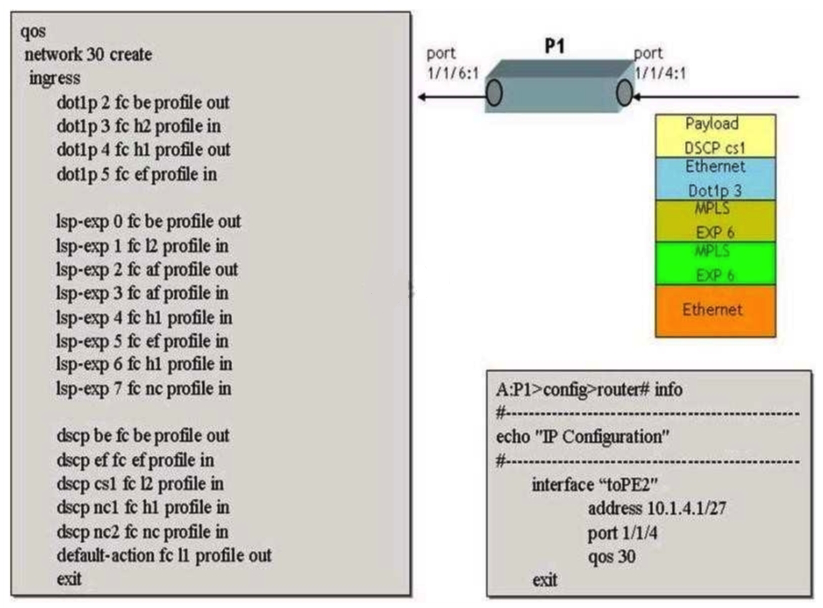 Based on the configuration of the network policy (below), what will be the forwarding class associated with a MPLS encapsulated customer packet that arrives on a dotlQ encapsulated network port 1/1/4:1 on P1 with the following characteristics: EXP value = 6 DSCP value = cs1 Dot1pvalue = 3
Based on the configuration of the network policy (below), what will be the forwarding class associated with a MPLS encapsulated customer packet that arrives on a dotlQ encapsulated network port 1/1/4:1 on P1 with the following characteristics: EXP value = 6 DSCP value = cs1 Dot1pvalue = 3
A) EF
B) H1
C) L1
D) H2
E) L2
 Based on the configuration of the network policy (below), what will be the forwarding class associated with a MPLS encapsulated customer packet that arrives on a dotlQ encapsulated network port 1/1/4:1 on P1 with the following characteristics: EXP value = 6 DSCP value = cs1 Dot1pvalue = 3
Based on the configuration of the network policy (below), what will be the forwarding class associated with a MPLS encapsulated customer packet that arrives on a dotlQ encapsulated network port 1/1/4:1 on P1 with the following characteristics: EXP value = 6 DSCP value = cs1 Dot1pvalue = 3A) EF
B) H1
C) L1
D) H2
E) L2

Unlock Deck
Unlock for access to all 198 flashcards in this deck.
Unlock Deck
k this deck
62
According to the SAP-egress policy configured and applied, which queue will forwarding class AF's traffic use? 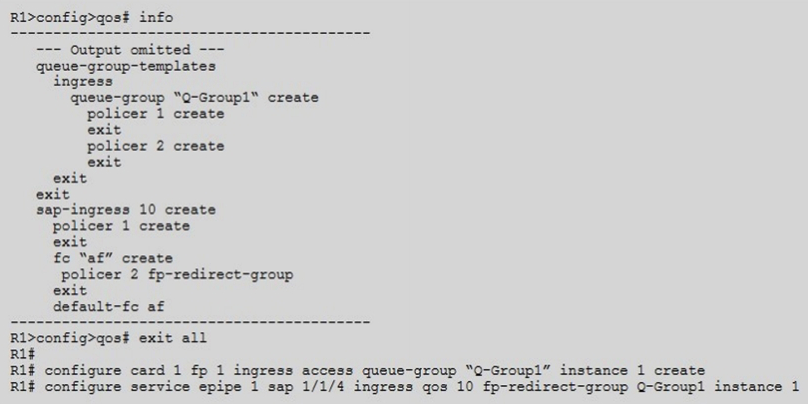
A) Policer 2 on the queue-group Q-Group1 instance 1.
B) Policer 1 on the queue-group Q-Group1 instance 1.
C) The default policer 1.
D) AF traffic is dropped.

A) Policer 2 on the queue-group Q-Group1 instance 1.
B) Policer 1 on the queue-group Q-Group1 instance 1.
C) The default policer 1.
D) AF traffic is dropped.

Unlock Deck
Unlock for access to all 198 flashcards in this deck.
Unlock Deck
k this deck
63
Which of the following policies does NOT exist by default on a network port?
A) A network policy for every network interface configured on the port.
B) A slope policy for the port on ingress.
C) A network queue policy for the corresponding MDA on ingress.
D) A network queue policy for the port on egress.
A) A network policy for every network interface configured on the port.
B) A slope policy for the port on ingress.
C) A network queue policy for the corresponding MDA on ingress.
D) A network queue policy for the port on egress.

Unlock Deck
Unlock for access to all 198 flashcards in this deck.
Unlock Deck
k this deck
64
According to the SAP-ingress QoS policy shown, which packets have a higher priority to enter queue 2? 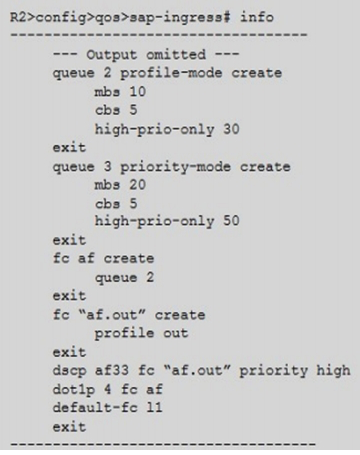
A) Packets marked with dscp = af33
B) Packets marked with dot1p = 4
C) All packets mapped to queue 2 have the same priority to enter this queue.
D) There are no packets mapped to queue 2.

A) Packets marked with dscp = af33
B) Packets marked with dot1p = 4
C) All packets mapped to queue 2 have the same priority to enter this queue.
D) There are no packets mapped to queue 2.

Unlock Deck
Unlock for access to all 198 flashcards in this deck.
Unlock Deck
k this deck
65
A queue-group template can contain both queues and policers when applied under which conditions?
A) When applied at the port level for access ingress.
B) When applied at the FP (Forwarding Pass) level for access ingress.
C) When applied at the FP (Forwarding Pass) level for network ingress.
D) When applied at the port level for network egress.
A) When applied at the port level for access ingress.
B) When applied at the FP (Forwarding Pass) level for access ingress.
C) When applied at the FP (Forwarding Pass) level for network ingress.
D) When applied at the port level for network egress.

Unlock Deck
Unlock for access to all 198 flashcards in this deck.
Unlock Deck
k this deck
66
Which of the following statements about the DiffServ and IntServ QoS models is FALSE?
A) IntServ uses a protocol like RSVP to provide QoS guarantees on a per-flow basis.
B) DiffServ groups multiple microflows into bigger streams called macro flows.
C) Intserv requires that network routers allocate resources for thousands of individual flows.
D) Diffserv classifies packets into forwarding classes only at the first network hop.
A) IntServ uses a protocol like RSVP to provide QoS guarantees on a per-flow basis.
B) DiffServ groups multiple microflows into bigger streams called macro flows.
C) Intserv requires that network routers allocate resources for thousands of individual flows.
D) Diffserv classifies packets into forwarding classes only at the first network hop.

Unlock Deck
Unlock for access to all 198 flashcards in this deck.
Unlock Deck
k this deck
67
Which of the following statements about behavior aggregate and multi-field classification in a Nokia 7750 SR is TRUE?
A) Multi-field classification can use both MAC criteria and IP criteria in the same SAP-ingress QoS policy.
B) Behavior aggregate classification can use both lsp-exp and dscp in the same SAP-ingress QoS policy.
C) Multi-field classification cannot use both IP criteria and IPv6 criteria in the same SAP-ingress QoS policy.
D) Behavior aggregate classification cannot use both dot1p and lsp-exp in the same SAP-ingress QoS policy.
A) Multi-field classification can use both MAC criteria and IP criteria in the same SAP-ingress QoS policy.
B) Behavior aggregate classification can use both lsp-exp and dscp in the same SAP-ingress QoS policy.
C) Multi-field classification cannot use both IP criteria and IPv6 criteria in the same SAP-ingress QoS policy.
D) Behavior aggregate classification cannot use both dot1p and lsp-exp in the same SAP-ingress QoS policy.

Unlock Deck
Unlock for access to all 198 flashcards in this deck.
Unlock Deck
k this deck
68
Which of the following statements about the token buckets of a policer is FALSE?
A) The CIR has no influence on the forwarding rate of the policer traffic.
B) The CIR influences whether a packet is considered high-profile or low-profile.
C) The policer discards all incoming packets when PIR bucket reaches the MBS level.
D) PIR bucket forwards packets that arrive with rates above PIR as out-of-profile.
A) The CIR has no influence on the forwarding rate of the policer traffic.
B) The CIR influences whether a packet is considered high-profile or low-profile.
C) The policer discards all incoming packets when PIR bucket reaches the MBS level.
D) PIR bucket forwards packets that arrive with rates above PIR as out-of-profile.

Unlock Deck
Unlock for access to all 198 flashcards in this deck.
Unlock Deck
k this deck
69
Which of the following egress points does NOT support egress reclassification?
A) Spoke-SDPs bound to an IES
B) Spoke-SDPs bound to a VPRN interface
C) SAPs
D) Network interfaces
A) Spoke-SDPs bound to an IES
B) Spoke-SDPs bound to a VPRN interface
C) SAPs
D) Network interfaces

Unlock Deck
Unlock for access to all 198 flashcards in this deck.
Unlock Deck
k this deck
70
Which of the following statements about scheduling on the Nokia 7750 SR is FALSE?
A) When using priority-mode queues, traffic marked as low-priority on ingress and scheduled in the above-CIR loop will be considered as in-profile at egress.
B) When using priority-mode queues, traffic marked as high-priority on ingress and scheduled in the above-CIR loop will be considered as out-of-profile at egress.
C) When using profile-mode queues, traffic marked as low-priority on ingress and scheduled in the above-CIR loop will be considered as out-of-profile at egress.
D) When using profile-mode queues, traffic marked as in-profile on ingress and scheduled in the above-CIR loop will still be considered as in-profile at egress.
A) When using priority-mode queues, traffic marked as low-priority on ingress and scheduled in the above-CIR loop will be considered as in-profile at egress.
B) When using priority-mode queues, traffic marked as high-priority on ingress and scheduled in the above-CIR loop will be considered as out-of-profile at egress.
C) When using profile-mode queues, traffic marked as low-priority on ingress and scheduled in the above-CIR loop will be considered as out-of-profile at egress.
D) When using profile-mode queues, traffic marked as in-profile on ingress and scheduled in the above-CIR loop will still be considered as in-profile at egress.

Unlock Deck
Unlock for access to all 198 flashcards in this deck.
Unlock Deck
k this deck
71
Which of the following is NOT an advantage of deploying queue-groups on a network port?
A) It enables fine-tuned SLA control that is not possible when using a common set of queues for all L2/L3 services.
B) It enables CFHP and hierarchy scheduling (egress) for each network interface.
C) It improves scalability by allowing the use of queues instead of the default set of policers used on network egress.
D) It allows for enforcing bandwidth reservations of the LSPs that are used by the SDPs configured on the network interfaces.
A) It enables fine-tuned SLA control that is not possible when using a common set of queues for all L2/L3 services.
B) It enables CFHP and hierarchy scheduling (egress) for each network interface.
C) It improves scalability by allowing the use of queues instead of the default set of policers used on network egress.
D) It allows for enforcing bandwidth reservations of the LSPs that are used by the SDPs configured on the network interfaces.

Unlock Deck
Unlock for access to all 198 flashcards in this deck.
Unlock Deck
k this deck
72
Which of the following statements about a SAP-ingress policy is FALSE?
A) It maps customer traffic to forwarding classes on ingress.
B) It can use customer QoS markings to do the mapping.
C) The default SAP-ingress policy classifies all traffic into FC "be" with low priority.
D) It serves the classification, queuing, and marking functions of QoS but does not serve scheduling
A) It maps customer traffic to forwarding classes on ingress.
B) It can use customer QoS markings to do the mapping.
C) The default SAP-ingress policy classifies all traffic into FC "be" with low priority.
D) It serves the classification, queuing, and marking functions of QoS but does not serve scheduling

Unlock Deck
Unlock for access to all 198 flashcards in this deck.
Unlock Deck
k this deck
73
Which of the following is a forwarding class type that is intended for network control traffic on a Nokia 7750 SR?
A) High-1
B) Assured
C) Best Effort
D) Expedited
A) High-1
B) Assured
C) Best Effort
D) Expedited

Unlock Deck
Unlock for access to all 198 flashcards in this deck.
Unlock Deck
k this deck
74
Which of the following fields is in the MPLS header?
A) 802.1p bits
B) Precedence
C) DSCP
D) EXP
A) 802.1p bits
B) Precedence
C) DSCP
D) EXP

Unlock Deck
Unlock for access to all 198 flashcards in this deck.
Unlock Deck
k this deck
75
Which of the statements about packet classification is TRUE?
A) It sets the destination IP address of the packet.
B) It uses RVSP to inform other QoS capable routers how the packet should be treated.
C) It sets the TOS, DSCP, EXP, or DOT1p field based on classification criteria.
D) It can use a customer's encapsulated data to determine a packet's forwarding class.
A) It sets the destination IP address of the packet.
B) It uses RVSP to inform other QoS capable routers how the packet should be treated.
C) It sets the TOS, DSCP, EXP, or DOT1p field based on classification criteria.
D) It can use a customer's encapsulated data to determine a packet's forwarding class.

Unlock Deck
Unlock for access to all 198 flashcards in this deck.
Unlock Deck
k this deck
76
How does an IOM3 improve the queue usage over an IOM2 in a Nokia 7750 SR? (Choose two)
A) The IOM3 adds more memory to both forwarding complexes which increases the total number of queues available.
B) The IOM3 only contains a single forwarding complex which reduces the number of queues used.
C) The IOM3 allows multiple forwarding classes to be assigned to a single queue.
D) The IOM3 allows queues to be dynamically allocated between ingress and egress.
E) The IOM3 has a larger CPU capable of tracking active hardware queue utilization and adjusting memory allocation accordingly.
A) The IOM3 adds more memory to both forwarding complexes which increases the total number of queues available.
B) The IOM3 only contains a single forwarding complex which reduces the number of queues used.
C) The IOM3 allows multiple forwarding classes to be assigned to a single queue.
D) The IOM3 allows queues to be dynamically allocated between ingress and egress.
E) The IOM3 has a larger CPU capable of tracking active hardware queue utilization and adjusting memory allocation accordingly.

Unlock Deck
Unlock for access to all 198 flashcards in this deck.
Unlock Deck
k this deck
77
Which of the following criteria is an IP multi-field classification option?
A) prec
B) lsp-exp
C) src-ip
D) do1p
A) prec
B) lsp-exp
C) src-ip
D) do1p

Unlock Deck
Unlock for access to all 198 flashcards in this deck.
Unlock Deck
k this deck
78
According to the SAP-ingress QoS policy shown, which of the following statements about processing of the packets by policers 3 and 4 is TRUE? 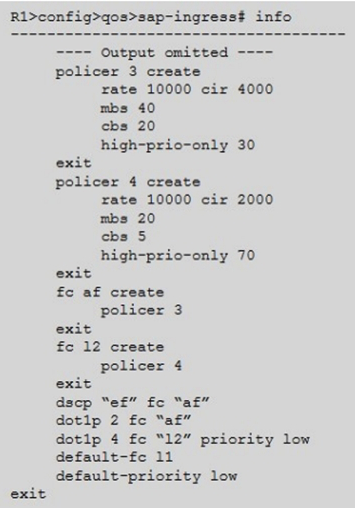
A) Policer 3 forwards packets as out-of-profile when its PIR bucket has 4000 tokens.
B) Policer 3 starts discarding low-priority packets when its PIR bucket has at least 3000 tokens.
C) Policer 4 forwards all its packets as out-of-profile.
D) Policer 4 starts discarding low-priority packets when its PIR bucket has at least 3000 tokens.

A) Policer 3 forwards packets as out-of-profile when its PIR bucket has 4000 tokens.
B) Policer 3 starts discarding low-priority packets when its PIR bucket has at least 3000 tokens.
C) Policer 4 forwards all its packets as out-of-profile.
D) Policer 4 starts discarding low-priority packets when its PIR bucket has at least 3000 tokens.

Unlock Deck
Unlock for access to all 198 flashcards in this deck.
Unlock Deck
k this deck
79
Which of the following statements about CIR of a queue is TRUE?
A) It may exceed PIR of the queue.
B) It may be exceeded by the average servicing rate of the queue.
C) It varies depending on the traffic characteristics.
D) It is the rate at which packets are forwarded out of the queue.
A) It may exceed PIR of the queue.
B) It may be exceeded by the average servicing rate of the queue.
C) It varies depending on the traffic characteristics.
D) It is the rate at which packets are forwarded out of the queue.

Unlock Deck
Unlock for access to all 198 flashcards in this deck.
Unlock Deck
k this deck
80
Which of the following is NOT a reason for configuring a slope policy on a queue?
A) To have control over the amount of the low priority packets that enter the queue.
B) To control any traffic flowing through the shared buffer space of the queue.
C) To limit the number of the TCP sessions that go into slow start during congestion.
D) To force the TCP algorithm to increase its transmission window upon detecting a congestion.
A) To have control over the amount of the low priority packets that enter the queue.
B) To control any traffic flowing through the shared buffer space of the queue.
C) To limit the number of the TCP sessions that go into slow start during congestion.
D) To force the TCP algorithm to increase its transmission window upon detecting a congestion.

Unlock Deck
Unlock for access to all 198 flashcards in this deck.
Unlock Deck
k this deck



